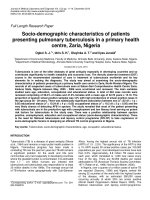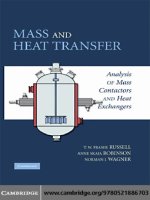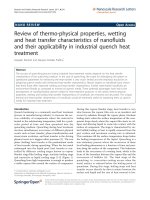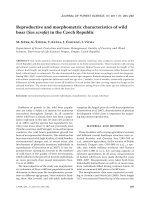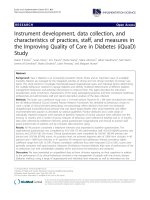Heat transfer characteristics of FC 72 flowing upward in vertical small diameter tubes
Bạn đang xem bản rút gọn của tài liệu. Xem và tải ngay bản đầy đủ của tài liệu tại đây (4.77 MB, 213 trang )
Kobe University Repository : Thesis
学位論文題目
Title
Heat Transfer Characteristics of FC-72 Flowing Upward in Vertical
Small Diameter Tubes(垂直細管内を上向流動するFC-72の熱伝達特性)
氏名
Author
Li, Yantao
専攻分野
Degree
博士(工学)
学位授与の日付
Date of Degree
2017-03-25
公開日
Date of Publication
2018-03-01
資源タイプ
Resource Type
Thesis or Dissertation / 学位論文
報告番号
Report Number
甲第6953号
権利
Rights
JaLCDOI
URL
/>
※当コンテンツは神戸大学の学術成果です。無断複製・不正使用等を禁じます。著作権法で認められている範囲内で、適切にご利用ください。
Create Date: 2018-09-19
Doctoral Dissertation
Heat Transfer Characteristics of FC-72 Flowing
Upward in Vertical Small Diameter Tubes
(垂直細管内を上向流動する FC-72 の熱伝達特性)
January 2017
Graduate School of Maritime Sciences
Kobe University
Yantao LI
(李延涛)
CONTENTS
Contents
ABSTRACT .................................................................................................................... iv
ACKNOWLEDGEMENTS ........................................................................................... ix
NOMENCLATURE ....................................................................................................... xi
FIGURE LIST ...............................................................................................................xiv
TABLE LIST .............................................................................................................. xviii
CHAPTER 1
Introduction ....................................................................................................................1
1.1 Research Background .........................................................................................................1
1.1.1 Basic concept of heat transfer in small channels .................................................1
1.1.2 Fundamentals of boiling heat transfer .....................................................................7
1.2 Literature Review.................................................................................................................14
1.2.1 Pool boiling heat transfer ..........................................................................................15
1.2.2 Single-phase heat transfer ........................................................................................16
1.2.3 Two-phase flow boiling heat transfer......................................................................23
1.3 Research Motivations.........................................................................................................24
1.3.1 Pool boiling heat transfer issue ...............................................................................24
1.3.2 Single-phase heat transfer issue .............................................................................24
1.3.3 Flow boiling heat transfer issue ...............................................................................26
1.4 Research Objectives...........................................................................................................26
1.5 Outline of Current Thesis ..................................................................................................27
References ...................................................................................................................................30
CHAPTER 2
Experimental Apparatus and Methods .................................................................39
2.1 Pool Boiling Experiments .................................................................................................40
2.1.1 Pool boiling apparatus................................................................................................40
2.1.2 Test section ...................................................................................................................42
2.1.3 Test fluid- water ............................................................................................................43
2.1.4 Experimental methods ................................................................................................45
2.2 Single-phase and Two-phase Flow Boiling Experiments .........................................47
2.2.1 Single-phase and two-phase flow boiling apparatus .........................................47
2.2.2 Test Section ...................................................................................................................58
2.2.3 Test Fluid – FC-72 ........................................................................................................69
2.2.4 Experimental methods ................................................................................................71
CHAPTER 3
i
CONTENTS
Pool Boiling Heat Transfer .......................................................................................85
3.1 Experimental Conditions ...................................................................................................85
3.2 Time Dependence of Pool Boiling Characteristics .....................................................87
3.3 Heat Transfer in the Non-boiling Region .......................................................................89
3.4 Steady State Pool Boiling Curve and Vapor Behaviors ............................................91
3.5 Transient Pool Boiling Curve and Vapor Behaviors ...................................................95
3.6 Steady State Pool Boiling CHF ........................................................................................97
3.7 Transient Pool Boiling CHF ............................................................................................ 100
3.8 Summary.............................................................................................................................. 103
CHAPTER 4
Single-phase Heat Transfer in Vertical Small Diameter Tubes ....................107
4.1 Steady State Turbulent Heat Transfer .......................................................................... 107
4.1.1 Experimental conditions .......................................................................................... 108
4.1.2 Experimental data of heat generation rate, surface temperature difference
and heat flux .......................................................................................................................... 113
4.1.3 Effect of u, L/d, μ/μw, Pr and Re .............................................................................. 115
4.1.4 Comparison with well-accepted correlations ..................................................... 126
4.1.5 Steady state turbulent heat transfer correlations.............................................. 130
4.2 Transient Turbulent Heat Transfer ................................................................................ 132
4.2.1 Experimental conditions .......................................................................................... 133
4.2.2 Characteristics of heat generation rate, heat flux and surface temperature
difference ............................................................................................................................... 133
4.2.3 Transient heat transfer coefficient......................................................................... 135
4.2.4 Transient Nusselt number........................................................................................ 141
4.2.5 Effect of Fo on transient turbulent heat transfer ............................................... 144
4.2.6 Effect of tube inner diameter on transient turbulent heat transfer ............... 146
4.2.7 Transient turbulent heat transfer correlation...................................................... 147
4.3 Summary.............................................................................................................................. 151
4.3.1 Steady state turbulent heat transfer ..................................................................... 151
4.3.2 Transient turbulent heat transfer ........................................................................... 152
References ................................................................................................................................. 154
CHAPTER 5
Subcooled Flow Boiling Heat Transfer in Vertical Small Diameter Tubes 157
5.1 Experimental Conditions ................................................................................................. 157
5.2 Heat Transfer Coefficient in Non-boiling Region ...................................................... 159
5.3 Time Dependence of Flow Boiling Characteristics .................................................. 160
ii
CONTENTS
5.4 Flow Boiling Heat Transfer Process ............................................................................. 163
5.4.1 Transition from the non-boiling region to film boiling through FDNB (type 1)
.................................................................................................................................................. 164
5.4.2 Transition from non-boiling regime to film boiling through a short nucleate
boiling or semi-direct transition (type 2). ...................................................................... 166
5.5 Steady State Flow Boiling CHF ...................................................................................... 167
5.5.1 Effect of flow velocity................................................................................................ 167
5.5.2 Effect of inlet subcooling ......................................................................................... 168
5.5.3 Effect of outlet subcooling ...................................................................................... 171
5.6 Transient Flow Boiling CHF ............................................................................................ 172
5.7 Summary.............................................................................................................................. 176
References ................................................................................................................................. 178
CHAPTER 6
Conclusions ...............................................................................................................179
6.1 Pool boiling Heat Transfer .............................................................................................. 179
6.2 Single-phase Heat Transfer in Vertical Small Diameter Tubes .............................. 180
6.2.1 Steady state turbulent heat transfer ..................................................................... 181
6.2.2 Transient turbulent heat transfer ........................................................................... 183
6.3 Subcooled Flow Boiling Heat Transfer in Vertical Small Diameter Tubes .......... 184
APPENDIX...................................................................................................................186
A.1 Wheatstone Bridge Method............................................................................................ 186
A.2. Kelvin Double Bridge Method ...................................................................................... 189
iii
ABSTRACT
ABSTRACT
Small channel heat exchanger has the capabilities to transfer high heat flux in
relatively small surface and volume. And it has been used in a wide variety of
applications including electronics devices, compact heat exchangers, refrigeration
evaporators and condensers and so on. However, several fundamental issues for small
channel heat transfer still exist and further study is necessary.
The aim of this thesis is to contribute to a better understanding of the underlying
physical phenomena in single-phase and two-phase flow boiling heat transfer in small
channels. For this purpose, a set of experimental apparatus cable of testing a wide range
of parameters such as tube inner diameter, heated length, flow rate, inlet liquid
temperature as well as exponential period of exponentially increasing heat input was
designed. It is mainly composed of a flow loop section, a heat input control system, a
data acquisition system and a test section assembly. The test section assembly was
designed and machined to ensure a fully developed turbulent flow in the test tube
without leakage, provide a mean of heating the test tube uniformly, and facilitate the
installation of measurement instruments. The measuring instruments were carefully
calibrated and associated experimental uncertainties were thoroughly analyzed. Hence,
the present experimental facility can be utilized to provide important data necessary to
iv
ABSTRACT
understand heat transfer characteristics in small diameter tubes. FC-72 was selected as
the test liquid as its low viscosity and surface tension are critically required for the
single-phase and two-phase flow boiling heat transfer in small flow channels.
Prior to experiments on heat transfer in small channels, pool boiling experiments
were conducted since the essential characteristics of the pool boiling CHF are retained
in flow boiling CHF. The study of pool boiling is necessary for better understanding of
flow boiling and its CHF. Chapter 3 presents and discusses the boiling heat transfer
experiments results. The steady state and transient CHF data for a wide range of
exponential period, system pressure and liquid subcooling were measured and studied.
It was found that the steady state CHF increase with the increase of subcoolings. And
although the steady CHF data for one atmosphere are in agreement with conventional
correlations, the CHF data for sub-atmospheric pressures show higher values. The
transient CHF values under sub-atmospheric pressures could be divided into two groups
based on exponential periods, corresponding to short period region and long period
region. The data in long period could be explained with conventional hydrodynamic
instability (HI) mechanism. The data in short period could be described with
explosive-like heterogeneous spontaneous nucleation (HSN) mechanism.
The steady state heat transfer process of turbulent forced convection of FC-72
v
ABSTRACT
through small diameter tubes was experimentally investigated. The effects of Reynolds
number, Prandtl number, ratio of the viscosity in the bulk to that at the wall (μ/μw) and
ratio of heated length to inner diameter (L/d) on turbulent heat transfer were studied in
detail. It was found that the heat transfer coefficient increases with the increase of flow
velocity, μ/μw and Prandtl number, and decrease of L/d .The experimental data were also
compared with the values calculated by classical correlations for conventional sized
channels. The results indicated that the classical heat transfer correlations are not
adequate for calculation of the heat transfer coefficient in small diameter tubes. It is
assumed that the roughness effect enhances the heat transfer rate in small sized channels.
The Nusselt numbers for inner diameter of 1 and 1.8 mm depend on Reynold number in
a different manner compared to that for inner diameter of 2.8 mm, which agrees with
conventional correlations. The deviation from conventional heat transfer correlations
increased as the Reynold numbers increase. The turbulent heat transfer correlations for
FC-72 flow in tubes with diameters of 1, 1.8 and 2.8 mm have been developed
respectively based on the experiment data. The differences between experimental and
predicted Nusselt numbers are within ±15%.
The transient heat transfer process due to exponentially increasing heat inputs for
turbulent flow of FC-72 was schematically investigated for different combinations of
vi
ABSTRACT
parameters such as flow velocity, inlet liquid temperature, period of exponentially
increasing heat inputs and test tube geometry. The effects of flow velocity, exponential
period and tube inner diameter on transient turbulent heat transfer process were
explored. It was found that the relation between transient Nusselt number and Fourier
number, Fo, with flow velocity as a parameter shows the same trend as heat tranfer
coefficient versus exponential period for each velocity. It was clarified that the transient
turbulent heat transfer due to exponentially increasing heat inputs could be analyzed by
introducing a dimensionless time, Fo. It was also found that the increment of transient
state data relative to the steady state is higher for smaller diameter. It might be assumed
that the effect of heat conduction contribution increases with a decrease of tube inner
diameter. The empirical correlations for transient turbulent heat transfer caused by
exponentially increasing heat inputs on small diameter tubes were developed based on
the effects of Fourier number and tube inner diameter. The empirical correlations
present the experimental data within ±25%.
Finally the subcooled flow boiling heat transfer experiments were conducted with
FC-72 in vertical tube with inner diameter of 1 mm and effective length of 26.2 mm for
exponentially increasing heat input with periods of 81.31 ms to 16.04 s. The flow
velocity varied from 3 to 5 m/s and the inlet liquid temperature changed from 293 K to
vii
ABSTRACT
333 K at a fixed outlet pressure of 300 kPa. The steady state flow boiling CHF values
increase with increase of flow velocity, inlet subcooling and outlet subcooling because
in such a situation a higher heat flux is required to initiate and sustain bubble activity.
Empirical correlations combing velocity and subcooling have been proposed. The
transition to film boiling process can be categorized into two types, representing two
different CHF mechanisms. The transition from non-boiling to film boiling through
FDNB and the transition from non-boiling region to film boiling through a short
nucleate boiling are named as type 1 and type 2 process. Type 1 occurs at steadily
increasing heat inputs and could be explained by conventional HI mechanism. Type 2
appears for rapid increasing heat inputs and it is induced by the explosive-like HSN
from originally flooded cavities. The transient flow boiling CHF values first increase
with a decrease in exponential periods up to a maximum CHF, then those decrease
down to a minimum one and again increase with a decrease in exponential period. The
transient CHFs due to exponentially increasing heat input could be divided into first and
second group for long and short periods. The first group data correspond to type 1
process. The second group data correspond to type 2 process.
viii
ACKNOWLEDGEMENTS
ACKNOWLEDGEMENTS
I would like to express my gratitude to my supervisor, Professor Fukuda Katsuya, for
his support, guidance and encouragement during my PhD study. His guidance improved
my research ability; his financial support enabled me to focus on study in the last year;
his hardworking sprit encouraged me to follow him. He availed himself for discussion
at any time although he has many other important responsibilities. Without his profound
comments and advises, this work would not have been possible.
I also wish to thank Professor Liu Qiusheng for his constructive advises throughout
the years. His humble and cautious attitude toward research is and will always be
valuable assets to me.
Much appreciation is also expressed to Professor Dan Tomohisa and Professor
Mimura Haruo for the thorough review of this thesis.
I am deeply thankful to the Japan Ministry of Education, Science and Culture for
granting me a fully funded scholarship and an opportunity to pursuit my PhD study.
I would also like to thank my seniors and my friends, Mr. Yamane and Mr. Sutopo,
for passing me the knowledge about the experimental facility and giving their kind and
useful advices. I acknowledge Dr. Zhao Zhou for his help and cooperation in the design
and manufacture of the test section. I am also grateful to the technician Mr. Ogawa and
ix
ACKNOWLEDGEMENTS
Assistant Professor Shibahara Makoto for their support and help in the daily work.
Special thanks to Dr. Wang Jingzhu for her constant encouragement. My gratitude
also goes to the doctoral students in my laboratory, Dr. Min and Dr. Wang Li, thank you
for making the lab such a pleasant and stimulating place to study.
Kind and warm care from my Japanese host family, the Inoues, is also acknowledged.
Last but not least, I would like to express thanks to my parents and my brother for
their love, encouragement and support all the time.
x
NOMENCLATURE
NOMENCLATURE
a, b
Br
C
cp
d
dre
do
Dh
constant in Eq. (2.10)
Brinkman number
constant in Eq. (4.15)
specific heat at constant pressure, J/kg K
inner diameter of the test tube, m
reference diameter in Eq.(4.7), 0.001 m
outer diameter of the test tube, m
hydraulic diameter, m
f
Fo
GrH
h
I
K1
K2
L
Le
m
friction factor
=ατ/ri2, Non-dimensional time, Fourier number
Grashot number
heat transfer coefficient, W/m2 K
current flowing through standard resistance, A
constant in Eq. (3.5)
constant in Eq. (3.6)
heated length, m
entrance length, m
mass of test tube, kg/m3
Nu, Nud
Nud,st
Nud,tr
(Nud,tr)cal
P
Pin
Pipt
Pl
Pout
Popt
Pr
= hd/λ, Nusselt number, transient Nusselt number
steady state Nusselt number
transient Nusselt number
calculated transient Nusselt number
pressure, Pa
pressure at inlet of heated section, Pa
pressure measured by inlet pressure transducer, Pa
pressure in liquid, Pa
pressure at outlet of heated section, Pa
pressure measured by outlet pressure transducer, Pa
=cpµ/λ, Prandtl number
Pv
Q
Q’
Q0
q
pressure in vapor, Pa
heat input per unit volume, W/m3
volumetric flow rate, m3/s
initial exponential heat input, W/ m3
heat flux, W/m2
xi
NOMENCLATURE
r∗
R1 to R3
Re Red
Rs
critical heat flux, W/m2
subcooled critical heat flux, W/m2
incipient boiling heat flux, W/m2
test tube radius, m
test tube inner radius, m
test tube outer radius, m
critical radius of spherical bubble, m
resistance in a double bridge circuit, Ω
=ud/ν, Reynolds number
resistance of standard resistance, Ω
RT
S
T
Tsat
Tin
Tin
TL
Tout
(Tout)cal
Ts
resistance of test tube, Ω
surface area, m2
temperature, K
saturation temperature, K
Incipience surface temperature, K
inlet liquid temperature, K
average bulk liquid temperature, K
outlet liquid temperature, K
calculated outlet liquid temperature, K
heater inner surface temperature, K
t
∆Tc
∆Ti
∆TL
∆Tsat
∆Tsub
∆Tsub,in
∆Tsub,out
u
V
time, s
superheat corresponding to CHF, K
superheat corresponding to boiling incipience, K
=(Ts-TL), surface temperature difference between heater inner surface
temperature and average bulk liquid temperature, K
surface superheat, K
liquid subcooling, K
inlet liquid subcooling, K
outlet liquid subcooling, K
flow velocity, m/s
volume, m3
V’
VFM
VI
VR
VI
voltage signal, V
voltage signal of flow velocity, V
voltage drop across standard resistance, V
voltage drop across the test heater, V
unbalance voltage of a double bridge circuit, V
qcr
qcr,sub
qi
r
ri
ro
xii
NOMENCLATURE
VTLi
VTLo
α
β
γ
δ
σ
λ
μ
μw
voltage signal of inlet temperature, V
voltage signal of outlet temperature, V
thermal diffusivity, m2/s
coefficient of volume expansion, 1/K
aspect ratio
wall thickness, m
surface tension, N/m
thermal conductivity, W/(m·K)
viscosity, N·s/m2
viscosity at tube wall temperature, N·s/m2
ρ
ρl
ρv
τ
υ
density, kg/m3
liquid density, kg/m3
vapor density, kg/m3
exponential period, s
kinematics viscosity of the fluid, m2/s
Subscripts
a
average
c
conduction
cal
calculated
h
hydraulic
in
inlet
out
outlet
L
liquid
s
surface
xiii
FIGURE LIST
FIGURE LIST
Fig. 1.1 Range of channel diameters employed in various applications [1] .............. 1
Fig. 1.2 Schematic of cooling of electronic components with small channel cooling
method [5]................................................................................................................. 4
Fig. 1.3 High-performance liquid cooling technology using microchannels ............. 5
Fig. 1.4 Schematic of compact heat exchanger ............................................................ 6
Fig. 1.5 Range of overall heat transfer coefficients for different fluids and cooling
modes ........................................................................................................................ 7
Fig. 1.6 Nucleation from a cavity................................................................................... 8
Fig. 1.7 Pool boiling heat transfer curve ...................................................................... 11
Fig. 1.8 Saturated and subcooled flow boiling regime ............................................... 14
Fig. 2.1 Schematic diagram of pool boiling apparatus .............................................. 40
Fig. 2.2 Test Heater ....................................................................................................... 43
Fig. 2.3 Schematic diagram of single-phase and two-phase flow apparatus ........... 49
Fig. 2.4 The relation of voltage signal and flow rate for the vortex flow meter ...... 54
Fig. 2.5 Calibration result of the thermocouple for measuring outlet temperature 57
Fig. 2.6 Cross-sectional view of test section ................................................................ 61
Fig. 2.7 Dimensions of test section (example of d = 1.8 mm)..................................... 62
Fig. 2.8 C-C Bakelite block .......................................................................................... 63
Fig. 2.9 A-A Bakelite plate ........................................................................................... 63
Fig. 2.10 B-B copper plate ............................................................................................ 63
Fig. 2.11 Photos of test section, Bakelite plate, Bakelite block and copper plate .... 64
Fig. 2.12 Resistance-temperature relation for tube of d=1 mm and L=50 mm ....... 67
Fig. 2.13 Turbulent Nusselt number at the thermal entrance of circular tube for
constant heat flux ................................................................................................... 69
Fig. 2.14 Power supply and data acquisition system ................................................. 72
Fig. 3.1 Typical changes of heat generation rate, heat flux and surface superheat
relating to elapsed time ( τ=20 s) ..................................................................... 87
Fig. 3.2 Typical changes of heat generation rate, heat flux and surface superheat
relating to elapsed time (τ=10 ms) ................................................................... 89
Fig. 3.3 Non-boiling heat transfer coefficient versus exponential period at TL=20
K .............................................................................................................................. 91
Fig. 3.4 Typical steady state boiling curve and critical heat flux due to
quasi-steadily increasing heat input with a period of 20 s ................................. 93
Fig. 3.5 Vapor behaviors on a horizontal cylinder caused by quasi-steady heat
xiv
FIGURE LIST
input with a period of 20s ..................................................................................... 93
Fig. 3.6 Pool boiling heat transfer process for subcooling of 0 K and 10 K at a
pressure of 50 kPa. ................................................................................................. 94
Fig. 3.7 Comparison of bubble behavior of typical heat transfer process for
subcooling of 0 K and10 K at a pressure of 50 kPa ............................................ 95
Fig. 3.8 Typical transient boiling heat transfer process and critical heat flux due to
rapidly increasing heat input. ............................................................................... 96
Fig. 3.9 Vapor behaviors of transient boiling under the pressure of 70 kPa ........... 97
Fig. 3.10 Change of steady CHF relating to subcoolings at 101.6 kPa ..................... 98
Fig. 3.11 Change of steady CHF relating to subcoolings at 30 kPa .......................... 99
Fig. 3.12 Steady state CHF versus pressures with liquid subcooling as a parameter
............................................................................................................................... 100
Fig. 3.13 Two groups of qcr in relation to exponential periods in saturated condition
at 50 kPa. .............................................................................................................. 102
Fig. 3.14 Relation between qcr and τ for subcooling ranging from 0 to 40 K at a
pressure of 50 kPa ................................................................................................ 103
Fig. 4.1 Relationship between h and τ for d=1.8 mm................................................ 111
Fig. 4.2 Relationship between h and τ for d=1 mm................................................... 111
Fig. 4.3 Relationship between h and τ for d=2.8 mm................................................ 112
Fig. 4.4 The relation of Q, ΔTL, q with time at period of 7.25 s (a) and 14.92 s (b) 114
Fig. 4.5 h varies with u at different ΔTL for d=1.8 mm ............................................. 116
Fig. 4.6 h varies with u at different ΔTL for d=1 mm ................................................ 117
Fig. 4.7 h varies with u at different ΔTL for d=2.8 mm ............................................. 117
Fig. 4.8 Effect of L/d on h for d=1.8 mm .................................................................... 118
Fig. 4.9 Effect of L/d on h for d=1 mm ....................................................................... 119
Fig. 4.10 Effect of L/d on h for d=2.8 mm .................................................................. 119
Fig. 4.11 Dynamic viscosity over temperature for FC-72 and water ..................... 120
Fig. 4.12 Effect of μ/μw on h for d=1.8 mm ............................................................... 121
Fig. 4.13 Effect of μ/μw on h for d=1mm ................................................................... 122
Fig. 4.14 Effect of μ/μw on h for d=2.8 mm ............................................................... 123
Fig. 4.15 Relation between Nud/Red1.2/(μ/μw)0.14 and Pr for d=1.8 mm ................... 123
Fig. 4.16 Relation between Nud/Red1.2/(μ/μw)0.14 and Pr for d=2.8 mm ................... 124
Fig. 4.17 Relation between Nud/Pr0.4/(L/d)-0.08/(μ/μw)0.14and Re for d=1, 1.8, 2.8 mm
............................................................................................................................... 126
Fig. 4.18 Comparison between experimental Nud and classical correlations for
conventional sized channels as a function of Red .............................................. 128
xv
FIGURE LIST
Fig. 4.19 Comparison between experimental Nud for d=1 mm and Adams’
correlation ............................................................................................................ 129
Fig. 4.20 Relation between Nud/Pr0.4/(L/d)-0.08/(μ/μw)0.14and Red for d=2.8 mm ..... 130
Fig. 4.21 Relation between Nud/Pr0.4/(L/d)-0.08/(μ/μw)0.14and Red for d=1 and 1.8 mm
............................................................................................................................... 131
Fig. 4.22 Time dependency of Q, q and ΔTL at various τ......................................... 134
Fig. 4.23 Instantaneous h versus t/τ at different τ.................................................... 136
Fig. 4.24 Instantaneous h versus ΔTL at different τ ................................................. 136
Fig. 4.25 h versus τ at various flow velocities for d = 1 mm .................................... 138
Fig. 4.26 h versus τ at various flow velocities for d = 1.8 mm ................................. 140
Fig. 4.27 h versus τ at various flow velocities for d = 2.8 mm ................................. 140
Fig. 4.28 Nud,tr versus Fo at various flow velocities for d = 1 mm .......................... 141
Fig. 4.29 Nud,tr versus Fo at various flow velocities for d = 1.8 mm ....................... 143
Fig. 4.30 Nud,tr versus Fo at various flow velocities for d = 2.8 mm ....................... 143
Fig. 4.31 Nud,tr /Nud,st versus Fo for d =1 mm ........................................................... 145
Fig. 4.32 Nud,tr /Nud,st versus Fo for d =1.8 mm ........................................................ 145
Fig. 4.33 Nud,tr /Nud,st versus Fo for d =2.8 mm ........................................................ 146
Fig. 4.34 Nud,tr /Nud,st versus Fo for d =1, 1.8 and 2.8 mm ....................................... 147
Fig. 4.35 Nuin versus Fo for d = 2.8 mm .................................................................... 148
Fig. 4.36 Nud,tr/(Nud,tr)cal versus Fo for d =1, 1.8 and 2.8 mm .................................. 150
Fig. 5.1 Non-boiling heat transfer coefficient versus exponential period at TL=30
K ............................................................................................................................ 159
Fig. 5.2 Typical changes of heat generation rate, heat flux and surface temperature
relating to elapsed time for transition to film boiling through FDNB ( τ=
15.68 s) .................................................................................................................. 161
Fig. 5.3 Typical changes of heat generation rate, heat flux and surface temperature
relating to elapsed time for semi-direct transition (τ=163.98 ms) ................. 162
Fig. 5.4 Typical flow boiling curves at τ=15.68 s and 163.98 ms ........................... 163
Fig. 5.5 Transition to film boiling through FDNB with quasi-steady heat input .. 165
Fig. 5.6 Semi-direct transition to film boiling process with transient heat input . 166
Fig. 5.7 Relation between q and Ts-Tin ...................................................................... 168
Fig. 5.8 Effect of inlet subcooling on boiling heat transfer curve ........................... 169
Fig. 5.9 qcr,sub versus ΔTsub,in at various velocities ..................................................... 170
Fig. 5.10 qcr,sub versus ΔTsub,out at various velocities.................................................. 171
Fig. 5.11 Typical transient CHF for various periods at ΔTsub,in=65 K .................... 172
Fig. 5.12 Typical ΔTc for various periods at ΔTsub,in=65 K ...................................... 173
xvi
FIGURE LIST
Fig. 5.13 Typical transient CHF for various periods at ΔTsub,in=55 K .................... 174
Fig. 5.14 Typical ΔTc for various periods at ΔTsub,in=55 K ...................................... 175
Fig. 5.15 Typical transient CHF for various periods at ΔTsub,in=45 K .................... 175
Fig. 5.16 Typical ΔTc for various periods at ΔTsub,in=45 K ...................................... 175
Fig. A.1 Circuit diagram of Wheatstone bridge ....................................................... 186
Fig. A.2 Circuit diagram of Kelvin double bridge ................................................... 189
xvii
TABLE LIST
TABLE LIST
Table 1.1 Flow channel classification scheme............................................................... 2
Table 1.2 Summarize of studies on heat transfer in small channels......................... 17
Table 2.1 Properties of water and FC-72 .................................................................... 44
Table 2.2 Comparison of inlet velocity and velocity measured with vortex
flowmeter ................................................................................................................ 53
Table 2.3 Physical properties of SUS304 .................................................................... 60
Table 2.4 Sizes of test tubes .......................................................................................... 60
Table 2.5 Summary of experimental errors and uncertainties ................................. 81
Table 3.1 Experimental conditions of pool boiling .................................................... 86
Table 4.1 Experimental conditions ............................................................................ 109
Table 5.1 Experimental conditions of flow boiling .................................................. 158
xviii
CHAPTER I
CHAPTER 1
Introduction
1.1 Research Background
1.1.1 Basic concept of heat transfer in small channels
1.1.1.1 Flow channel classification
Fig. 1.1 Range of channel diameters employed in various applications [1]
A flow channel serves for liquid flowing so that the heat transport process from the
wall surface to liquid is accomplished. Fig. 1.1 shows the ranges of channel dimensions
employed in various systems. A shift from larger diameters, on the order of 10–20 mm,
to smaller diameter channels occurs with the development of mini and micro technology.
1
CHAPTER I
Since the dimensions of interest are in the range of a few tens or hundreds of
micrometers to several millimeters, they are assumed to be small channels for science
and engineering associated with processes at this scale.
A flow channel classification proposed by Mehendale et al. [2] classifies the
dimension from 1 to 100 μm as microchannels, 100 μm to 1 mm as meso-channels, 1 to
6 mm as compact passages, and greater than 6 mm as conventional passages.
Table 1.1 Flow channel classification scheme
Conventional channels
d > 3 mm
Minichannels
3 mm ≥ d > 200 μm
Microchannels
200 μm ≥ d >10 μm
Transitional Microchannels
10 μm ≥ d >1 μm
Transitional Nanochannels
1 μm ≥ d >0.1 μm
Nanochannels
0.1 μm ≥ d
Kandlikar and Grande [1] slightly modified the above classification method, and
proposed a more general scheme as shown in Table 1.1. This classification scheme is
generally adopted in literature.
2
CHAPTER I
1.1.1.2 Small flow channel applications
Small flow channel cooling method has been widely used due to the capabilities to
transfer high heat flux in relatively small surface and volume. The heat removal
enhancement is achieved through increase of heat transfer coefficient and heat exchange
surface (for a certain volume) with the decrease of channel size accompanying with a
higher pressure drop. A balance between heat transfer enhancement and pressure drop
for different applications leads to different channel dimensions. Fig. 1.1 shows the main
applications with corresponding channel dimensions range, including electronics
cooling, compact heat exchangers, refrigeration evaporators and condensers and so on.
The details are described as follows.
a) Electronics cooling
The thermal load for electronic devices has risen significantly in the rescent years.
Dr.Moore predicted that the number of transistors on an intergrated circuit would
double every 18 months. The truth is that an exponential growth of number of
transistors in circuits has been developed following the Moore Law in the past decades.
This results in rapid increase of the internal resistance of the component as well as the
internal heat generation. The new challenge for the coming decade is on the order of
600-1000W/cm2 [3]. So high heat flux dissapation in compact structures requires
3
CHAPTER I
efficient cooling system. Single-phase and two-phase flow boiling heat tranfer inside
small channels is one of the efficient canditates of maintaining desired temperature
difference for these electronic devices. Fig 1.2 shows the schematic of cooling of
electronic components with small channel cooling method. The basic concept of
miniturization was first devolved by Tuckerman and Pease [4]. They demonstrated
cooling of 7.9 W/cm2 with a maxium temperature increase of 71℃ by reducing the
channel size into micro scale. The pressure drop was also as high as 200 kPa. This is the
main disadvantage of miniaturization.
Fig. 1.2 Schematic of cooling of electronic components with small channel cooling
method [5]
Colgan et al. [6] at IBM published a practical implementation of a silicon
microchannel cooler as shown in Fig. 1.3 for high-power chips. They argued that it is
not practical to form the microchannels directly on the chip given the high cost of
4
